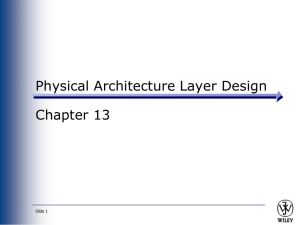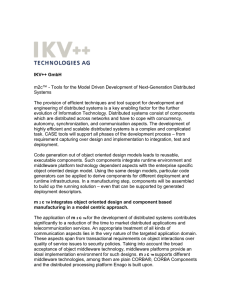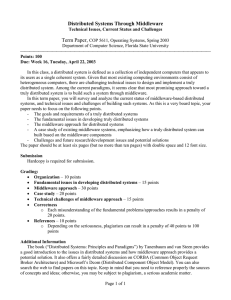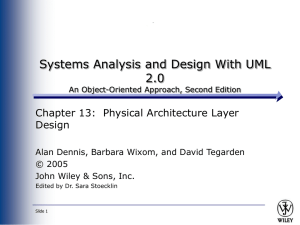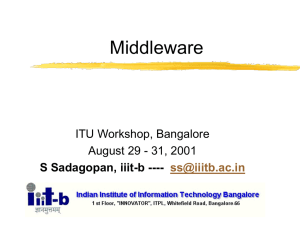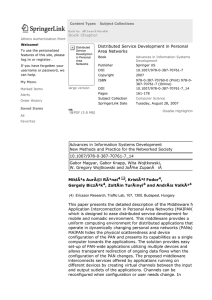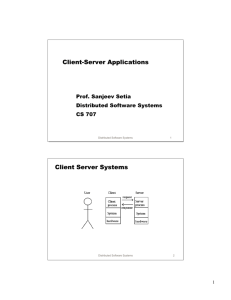Middleware or Simulator for Autonomic Communications Yang Qiu Networking Laboratory
advertisement
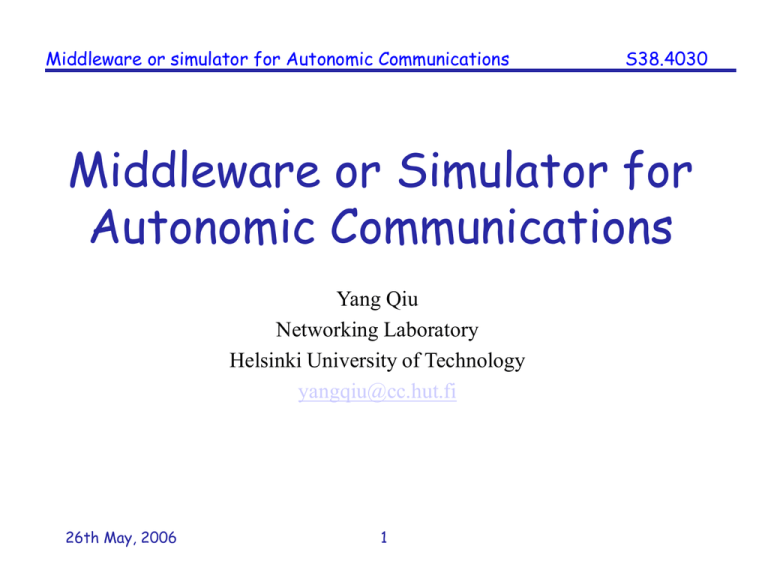
Middleware or simulator for Autonomic Communications S38.4030 Middleware or Simulator for Autonomic Communications Yang Qiu Networking Laboratory Helsinki University of Technology yangqiu@cc.hut.fi 26th May, 2006 1 Middleware or simulator for Autonomic Communications S38.4030 The complexity of Autonomic Communications dynamically build up the personal networking system. – The devices, terminals or nodes are mobile. – The devices, terminals or nodes can join in or leave dynamically. enable multiple services on various of networks. – Collecting the information is costly active. – With the increasing of scale, the collecting spend more resources. implement the adaptation of network. – The adaptation of scale of sensor in network. – The adaptation of node topology, network connectivity, and node mobility. – The adaptation of computation and energy constraints build full automating the maintenance and optimization of large computer system. – Human adjustment is very expensive. – The work load of human adjustment will becomes very huge. Wireless networks need extra management. 26th May, 2006 2 Middleware or simulator for Autonomic Communications S38.4030 The Problems of Autonomic Communications What do I need to support ubiquitous applications? – Communication adaptability and extensibility • Explicit knowledge of how communication protocols compose and interact is required • A semantic model capable to assure safe adaptation is needed Distributed systems evolve dynamically and components interact with an environment that is not under their control Communication protocols provided in current middleware frameworks are tailored to specific and usually static requirements not suitable for dynamic environments Reflection has been used to achieve both separation of concerns and dynamic adaptation to changing environments requirements 26th May, 2006 3 Middleware or simulator for Autonomic Communications S38.4030 Middleware is the key element of autonomic communications Middle ware is the key element of sharing the collected information – A self management middle ware is needed, which should implement the collection, aggregation, maintenance, and dispersion of heterogeneous information. Middle ware is the key element of building the cooperating objects, – hidden the complexity for application development for different kinds of communication environment. Middle ware is the key element of adaptation of different protocols and nodes. – The network needs an adaptive middle ware, which automatically discern needed parameters settings or software usages and adjust them automatically. Full automation without any human efforts. – Simply the maintenance and optimization of human effort. 26th May, 2006 4 Middleware or simulator for Autonomic Communications S38.4030 Functionality of Middleware Quality and quantity of collected information. – Higher quality will lead more successfully self management. – To collect Higher quality is a relatively more costly activity in self management process. – Common information should be used to minimize the cost of collecting information Cooperating objects – Realizes a distributed platform of interfaces and services that reside between the applications and the devices. – This approach is denoted as a reflective middleware. event and device manager – Sensor application adaptivity and updates. Full automation without any human experts. – Top-down approaching to capitalize on opportunities to optimize at system–wide level. 26th May, 2006 5 Middleware or simulator for Autonomic Communications S38.4030 Dynamic adaptive middleware and reflective middleware Adaptive middleware – Can change functional or non-functional constraints. • Statically, it leverages the capabilities of specific platform or environment the middleware runs in. • Dynamically, it allows application to run with optimum system responses where the requirements or environment is changing. A reflective middleware is a approach to build dynamically adaptive middleware – Based on Computational Reflection Concept • Reification and Absorption • Meta-level architectures, meta-objects and meta-object protocols. • Structure and behavioral reflection. – A reflective system • Supports Causally Connected Self Representation (CCSR). • Can reason about and act up itself. Is able to inspect and change itself during the course of its execution (inspection & adaptation). 26th May, 2006 6 Middleware or simulator for Autonomic Communications S38.4030 reflective middleware Definition: Reflective Middleware is simply a middleware system the provides inspection and adaptation of its behavior through an appropriate CCSR Features – Open model, composed of group of collaborating components. – Support for dynamic customization of components, accessible through meta-level interfaces. – Gives a two or multi level view of system • Base: application objects • Meta level: internal representation of middleware components 26th May, 2006 7 Middleware or simulator for Autonomic Communications S38.4030 How can reflective middleware help Autonomic Communications A communication reflective framework – Allows dynamic customization of communication protocols (high adaptability and extensibility) – Constraints composition of services and protocols in order to prevent functional interference that could lead to an inconsistent configuration state of the system (safe flexibility) – Helps to identify and reason about issues of correctness, which may be subtle and complex • fluctuations in the communication environment may interfere with the execution of communication protocols and middleware services 26th May, 2006 8 Middleware or simulator for Autonomic Communications S38.4030 Example 1: The middleware of Collective The middleware provide the common information for all the nodes. – The common information should be collected only once to minimize the cost of process. – The Middleware of Collective is an independent information service for self-managed middleware platforms. – The service provides an effective support service for the collection and management of information. – The Middleware is designed to reduce the effort needed to collect the information from an environment. 26th May, 2006 9 Middleware or simulator for Autonomic Communications S38.4030 The Middleware of Collective Service 1 (i.e. Multimedia service) Performance Interceptors Network Activity Service 2 (i.e. Video conference) Performance Interceptors Client Feedback Network Activity Service 1 (i.e. Multimedia service) Client Feedback Service 2 (i.e. Video conference) The Middleware of Collective Performance Interceptors 26th May, 2006 Network Activity Client Feedback 10 Performance Interceptors Network Activity Client Feedback Middleware or simulator for Autonomic Communications S38.4030 The overview of Middleware of Collective The middleware is broken into following parts: – Resource Registry. Listing of available information source. – Local Service Container. Information collection and analysis entities located within the platform. – Remote Source Container. Offers facilities to hook-in external and legacy information sources to the platform. – Container Services. Support services for both local and remote containers within The Collective. Services include persistence, transaction and distribution. 26th May, 2006 11 Middleware or simulator for Autonomic Communications S38.4030 The Middleware Deployment options The most straightforward deployment is as a standalone server to manage information consumers and producers within self-managed systems. Another way is to distribute the service in multiple physical sites each containing large collections of self-managed systems. – A key benefit of the service is its capability to interconnect to share information between multiple services and locations. There are a number of projects do possess comprehensive information capabilities and represent and manage it in a variety of manners. – – – – K-Components Open ORB The Quality Objects (QuO) SNMP 26th May, 2006 12 Middleware or simulator for Autonomic Communications S38.4030 Example 2: the middleware for Cooperating Objects The middleware must have a conceptual model of its current state and the preferences of the user. If we want the network works seamlessly in both environments of client-server and ad-hoc. the “server” needs to be distributed among all members of the ad-hoc community. It leads the system to operate on the peer-to-peer paradigm. It’s possible to implement it with necessary enhancements on existing results, particularly from the IETF and OMG. – – – – IP Wireless CORBA Super Distributed Objects Model Driven Architecture 26th May, 2006 13 Middleware or simulator for Autonomic Communications S38.4030 Example 3: the middleware of Impala The middleware of Impala must provide the longterm management of the sensor application software. – By adopting a middleware layer that can update and adapt applications dynamically, new protocols can be plugged in at any time, and switches between protocols can be performed at will. The Impala uses a middleware layer that is intended to act as an operating system, resource manager, and event filter on top the specific applications which can be installed and run. 26th May, 2006 14 Middleware or simulator for Autonomic Communications S38.4030 The Middleware of Impala There are 3 middleware of Impala: – The Application Adapter adapts the application protocols to different runtime conditions to improve performance, energy-efficiency and robustness. – The Application Updater receives and propagates software updates through the wireless transceiver and installs them on the node. – The Event Filter captures and dispatches events to the above system units and initiates chains of processing. Application Initialize Application Terminate The Middleware of Update updater Application Query Send Done Handler Packet Handler Timer Handler Timer Handler The Middleware of Application Adapter The Middleware of Event Filter Device Event 26th May, 2006 Send Done Event 15 Packet Event Time Event Data Event Middleware or simulator for Autonomic Communications S38.4030 The system-wide autonomic computing The middleware does not provide the a top-down approach to developing autonomic systems. – such an approach fails to address the effects of interactions between various components and does not capitalize on opportunities to optimize at a system-wide level. In order to enable the network systems incrementally tune themselves based on observed usage patterns and enable the network systems to adapt to changes in connectivity due to system failures and/or component upgrades. – Machine learning, it’s the fundamental challenges. – A top-down approaching way of developing autonomic systems. The autonomic components of entire system should work well, not just independently, but in concert with other such components. 26th May, 2006 16 Middleware or simulator for Autonomic Communications S38.4030 The Study is still needed for system-wide autonomic computing A high-level simulator can be used to facilitate the study of machine learning in a complex network systems. – A high-level simulator is needed, it is capable of modeling the relevant types of interactions among the many different components of a computer system. – But detailed simulators exist for individual system components, such as networks, databases, etc. Till now there is no simulator that models system-wide interactions. – Therefore, a study system must simulate the way of a computer network processes from a high-level perspective. Example: The simulator of Job Routing and Scheduling – The simulator is very general purpose and can be used to represent many different kinds of networks of the Job Routing and. • Simulator includes the following the components: – – – – – – – 26th May, 2006 Nodes Users Machines Links Packets Jobs steps 17 Middleware or simulator for Autonomic Communications S38.4030 The simulator of Job Routing and Scheduling The simulator provides a valuable test bed for new approaches to autonomic computing. Because: – The simulator is very general, it can be used to represent a wide variety of computer systems with arbitrary topology. – The simulator is highly modular which makes it easy to insert intelligent agents to control any aspect of the system’s behavior. – The simulator captures many of the real world problems associated with complex computer systems while retaining the simplicity that makes experimental research feasible. – The simulator provides evidences of the value of combining intelligent, adaptive agents at more than one level of the system: • machine learning methods offer a substantial advantage in optimizing the performance of computer networks. • the best performance is achieved only by placing intelligent, adaptive agents at more than one level of the system. 26th May, 2006 18 Middleware or simulator for Autonomic Communications S38.4030 Conclusion The reflective middleware can be used for Collective and Cooperating Objects. Multi-layered Middleware supports multiple applications by adopting an event-based modular programming model and providing a friendly programming interface. And Multilayered middleware also provide a lightweight system layer to perform dynamic application adaptation based on parameters and device failures and automatic application updates based on a specialized software management and transmission mechanism. The middleware does not provide the system-level optimization. 26th May, 2006 19

